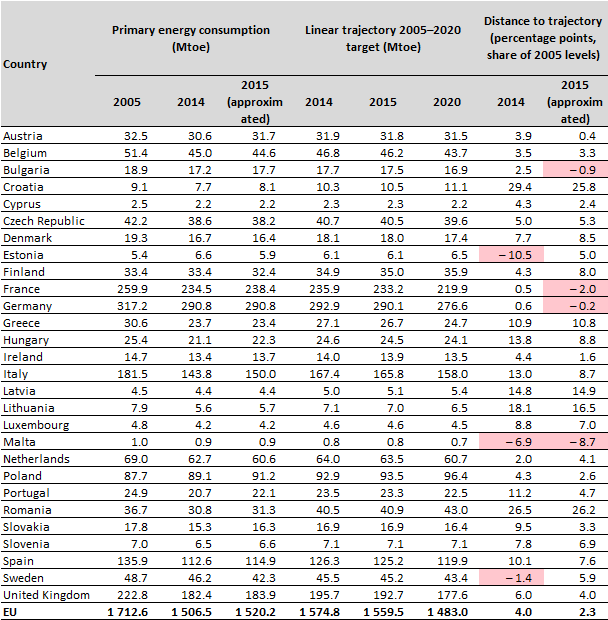1 Reporting requirements for energy efficiency/energy consumption
Under Article 3 of the Energy Efficiency Directive (EED) (EU, 2012), Member States had to set their own indicative national energy efficiency targets. Depending on country preferences, these targets are based on primary or final energy consumption, primary or final energy savings, or energy intensity. Each national target reflects the specific situation of the Member State that adopted it. In some Member States, the targets may still be subject to change in the coming years.
2 Data sources for energy consumption
The analysis presented in this report is based on several sources relating to energy consumption in Europe.
Historic trends of primary and final energy consumption
The assessment of progress towards energy efficiency targets is, for the most part, based on information reported by Member States to Eurostat under the Energy Statistics Regulation, and published by Eurostat via its energy statistics database (Eurostat, 2016a, 2016b and 2016c).
Approximated estimates for primary and final energy consumption in 2015
Early estimates of 2015 primary and final energy consumption were prepared by the European Environment Agency (EEA, 2016a and 2016b).
National targets on primary and final energy consumption
The assessment of progress towards energy efficiency targets is based on the targets set under Article 3 of the EED in 2013, including updates as notified by Member States in their 2014 national energy efficiency action plans (NEEAPs) or in a separate notification to the European Commission in 2015 (EC, 2015). The most recent updates were reported by Denmark and Hungary in 2016 (EC, 2016).
3 Tracking progress towards energy efficiency targets
The analysis of progress made towards achieving energy efficiency targets at national levels involves assessing whether or not the efforts undertaken since 2005 have been sufficient to reduce or limit primary energy consumption at a pace sufficient to meet the 2020 target. This question can be addressed by comparing 2014 (or 2015) levels with a linear trajectory between 2005 and the 2020 national target.
This linear assessment is applied to track energy efficiency progress for the following reasons:
- unlike renewable energy sources (RESs) and greenhouse gas (GHG) emissions, reliable projections and/or targets for interim years until 2020 on energy consumption are not available at Member State level;
- no other indicators/parameters/methodologies with a transparent, well-established and statistically known relationship to primary energy consumption are available.
Therefore, this assessment is based on the comparison between average historic trends and the trends deemed necessary to achieve 2020 targets. To remain consistent with the assessments presented for GHG emissions and RESs, the year 2005 was chosen as a single base year, to allow for the comparable assessment of trends across Member States. This methodology does not take into account the level of ambition of the national target (which varies significantly across the European Union (EU)), nor does it capture the complexity of the national context (economic development, ability to attract financing for energy efficiency projects, etc.). Several Member States defined their 2020 targets in terms of final energy consumption (instead of primary energy consumption): Austria, Croatia, the Czech Republic, Estonia, Finland, France, Greece, Lithuania, Latvia, Slovakia and the United Kingdom. For the purpose of cross-country comparison, the officially reported primary energy consumption target was taken into account in this assessment.
The numeric results of this assessment per Member State are shown in greater detail in Table A3.1 below.
Table A3.1 Member States’ progress towards their 2020 energy efficiency targets

Note: The distance to a trajectory is calculated as ‘linear trajectory value’ – ‘primary energy consumption’. A positive value indicates an energy consumption below the linear trajectory.
Source: EC, 2015 and 2016; EEA, 2016b; Eurostat, 2016b and 2016c.

Document Actions
Share with others